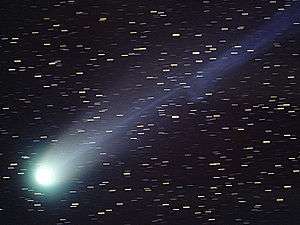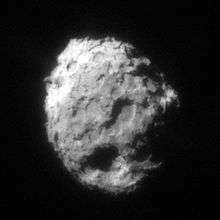Comet Yi–SWAN
 | |
| Discovery | |
|---|---|
| Discovered by | Dae-am Yi, SWAN instrument on SOHO spacecraft |
| Discovery date | March 26, 2009 |
| Orbital characteristics A | |
| Epoch | 2009-May-22 |
| Aphelion | 904 AU[1] |
| Perihelion | 1.274072 AU |
| Semi-major axis | 453 AU[1] |
| Eccentricity | 0.997031 |
| Orbital period | ~9,600 yr[1] |
| Inclination | 85.7668 |
| Last perihelion | April 7, 2009 |
| Next perihelion | 13462 |
Comet C/2009 F6 (Yi–SWAN) is a non-periodic comet which appeared in March 2009.
It was first discovered by Korean amateur astronomer Dae-am Yi on March 26, 2009, using a Canon 5D camera and 90-mm lens. It is believed to be the first comet discovered by a Korean in the modern age.[2] Independently, on April 4 Rob Matson reported he had discovered a comet in the SWAN instrument photographs on the SOHO (Solar and Heliospheric Observatory) spacecraft website.[3]
The comet was not bright enough to be seen by the naked eye, but was theoretically visible through amateur telescopes. However, it was harder to see than predicted, as it remained quite small and did not form much of a visible tail. It reached a peak magnitude around +8.5 in April into May, and passed 1.5 degrees south of the Double cluster in Perseus on April 23.[3]
References
- 1 2 3 Horizons output. "Barycentric Osculating Orbital Elements for Comet C/2009 F6 (Yi-SWAN)". Retrieved 2011-02-03. (Solution using the Solar System Barycenter and barycentric coordinates. Select Ephemeris Type:Elements and Center:@0)
- ↑ Meyer, Maik. "Forum communication". Retrieved 2009-04-13.
- 1 2 Sinnott, Robert (2009-04-08). "New Circumpolar Comet Yi-SWAN". Sky and Telescope. Retrieved 2009-04-13.
External links
- "JPL Small-Body Database Browser". NASA.
- Comet C/2009 F6 Yi-SWAN – Heavens-Above

